
The Rubber Mills Blues
(written by Jenny DeRocher, Archives staff)
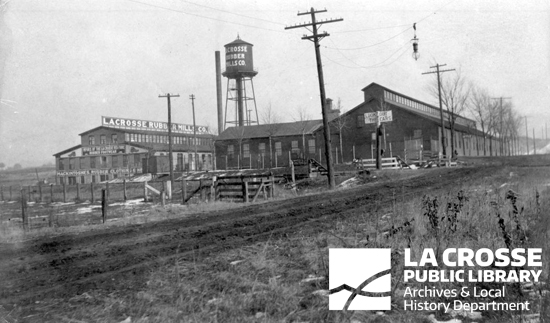
The La Crosse Rubber Mills Company, Inc. opened its doors in 1897 on La Crosse's North Side. In the early years, the company manufactured rubber goods such as carriage covers, coats, suits, horseshoe covers, and mackintoshes (rubber coats). By 1906, however, they made the switch to producing solely rubber footwear. For the first few decades of the company, these goods were handstitched and employees became experts in the craft of shoemaking.
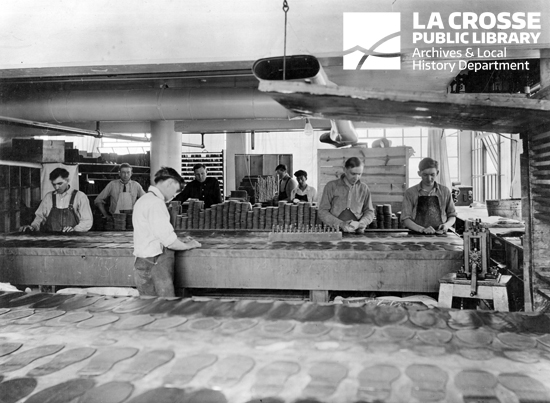
The process of making rubber goods was relatively new at the time—the vulcanization process that creates the durable, hardened rubber we know today had just been patented in 1840s by Charles Goodyear. Vulcanization allowed rubber to become the useful commodity it is now—perhaps most importantly to our modern world—as an insulator in machinery and the material tires are made out of for bikes, tractors, cars, trucks, planes, etc.

In his oral history from the UW-La Crosse Oral History Program, Thomas Taylor shared, “In the mill room safeties were not real good. They have now upgraded the stuff. One part of a machine, that they have a really good safety on now, caused a real good friend of ours, whom we used to spend a lot of our summers with, it actually took his life. He lost his hand in the machine and stretched an artery…. You had to constantly think about what you were doing on your job. If you made a mistake, you’d lose a hand. There were a lot of people losing hands.”
As a commodity, rubber has a complex history with global impact on many peoples, economies, and cultures. To meet the demand of the technological advancement in the 19th and 20th centuries, many companies went to exploitative extremes for the demanding rubber market. In some areas of the world—like Liberia, the Belgian Congo, Malaysia, Sri Lanka (then referred to as Ceylon), and the Amazon Rainforest in South America—that meant labor practices that fit within the definition of slavery. In turn, these global practices ensured that rubber stayed cheap for western goods.
However, that doesn’t mean that the working-class employees of the rubber industry in western countries were free of the rubber industry's exploitation. In the rubber factories of England and the U.S., meeting the demanding market meant unsafe environments. Factories often had poor ventilation and were known to be extremely warm, noisy, dirty, and often at risk of fires. Toxic chemicals irritated lungs and caused headaches and hallucinations. These are all things that were true of the La Crosse Rubber Mills, according to some first-hand accounts.
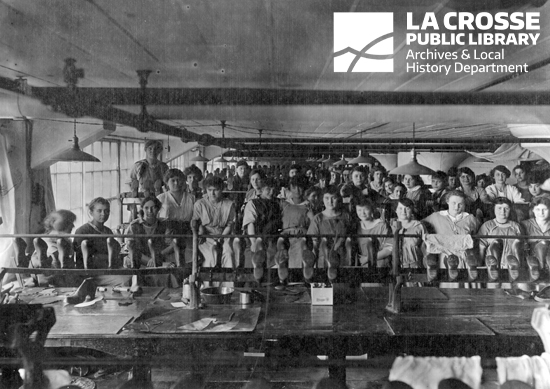
One man, Herman Tietz, worked at the Rubber Mills starting around 1908 was recorded in a 1960s oral history interview by Howard Fredricks, who was the founder of the UW-La Crosse Oral History Program. Today, we can listen to these interviews to hear a slice of what life was like for individuals who worked at the Rubber Mills. Here is a small excerpt of this interview:
Listen Here: Tietz_Herman_OHP_Clip.wav
[TRANSCRIPT]
Howard Fredricks (interviewer): Was the Rubber Mills there in 1903?
Herman Tietz: It was just an old shack—just a red shack. The first thing they had—they started with, uh, raincoats! And then they, uh, started making shoes.
Fredricks: And was Funk in charge at that time? In the beginning?
Tietz: Yeah, I believe Funk—I think Old Funk was the first one.
Fredricks: And that was located where it is now?
Tietz: Right now, yep. A one-story shack. And they made shoes in there.
Fredricks: Rubber shoes?
Tietz: Yep. I worked there for a while. I worked there in 1907, I believe—1908 I worked there.
Fredricks: What did you do?
Tietz: Made shoes. We had to work two weeks for nothing. They’re called strikers. If you went in and started making shoes, why, you worked with another fellow and learned how to do it, you know. You worked for two weeks and you didn’t get paid, didn't get paid at all. And then they'd give you twenty-four pairs of tennis shoes to make or twelve pair four-buckle overshoes. You would have to lay your lining and put cement on them the night before so it would be dry the next morning and have that laid out and then your insoles and juniors all the different things. And you had to get your lathes and you put your lining over and get your insole in there and then put it over and then put your right sole on and your counter in the back and then your vamp and your uppers and then your foxing and then your, uh, outsole. You had to put all that on and roll it down and stitch it.
Fredricks: You would make the shoe from scratch then?
Tietz: From scratch, yes. Yeah.
Fredricks: And you were supposed to make how many?
Tietz: Well, uh, when you started out, well, you just made about twelve pair. I made as high as thirty pair of overshoes—
Fredricks: In one day?
Tietz: In one day. And if you made eighteen dollars a week, boy I’ll tell ya what, that was a lot. The guys used to get sore, you know, when you made that much money.
Fredricks: Who would make…you sore?
Tietz: The other guys who didn’t make that many shoes, you know—
Fredricks: Oh, you were paid by the piece?
Tietz: Sure, every piece.
Fredricks: How much?
Tietz: Well, I forget now just exactly how much we got paid per the piece but I remember that, uh, one day—one week I got eighteen dollars and the other guys were getting thirteen and fifteen dollars and, boy, they didn’t like that at all, you know. My brother, he was working in the office there, and he was making out the list for making shoes and then they always used to say that he was favoring me, you know. And pray for that there, right, he always made it tougher for me because he didn’t want to have that said. He would give me the big sizes and the real small sizes—the real small sizes are just as hard to make as the big sizes. The ones in between, why, you could handle them faster.
Fredricks: Was each finished product inspected?
Tietz: Yes, after it was cured, you know, they’d take them and cure them. And you had to stab them--
Fredricks: What do you mean, ‘cured’?
Tietz: Cured. Put through the, uh, heat!
Fredricks: You make—you make the shoe...and then?
Tietz: Yeah, and they put ‘em—they’d put them into the ov—like, an oven, you know, and cure ‘em! Uh, in the morning, they’d open—open up and that stuff would come in and, boy, you’d get drunk from that—uh, you know, a lot of—you’d get sick! You’d definitely get sick and definitely get drunk from breathing that. It wasn’t ventilated, you know. Now they got it all—they got it different. It was tough. They had it all—it was just blue in there! And if it was cold, you know, you couldn’t open a window or anything of that kind because if you open a window, the shoes—it would get frost, you know, they would dry out too fast and it wouldn’t stick.
[end TRANSCRIPT]
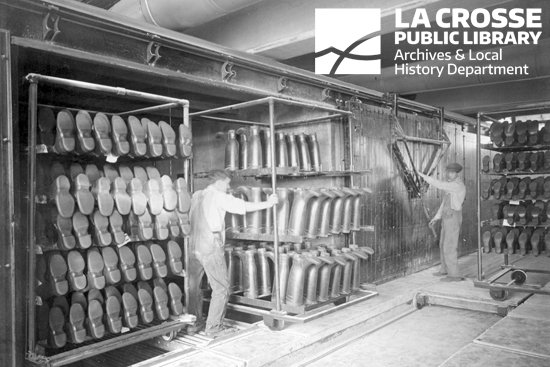
Despite some of the dangerous conditions Tietz and Taylor described in their interviews, you can still sense the pride in Tietz's narrative for the work they accomplished. In many primary sources, it is evident that people employed by the Rubber Mills shared this pride in their role of making some of the best boots and shoes in the country. The La Crosse Rubber Mills was one of the largest employers in the city for a majority of the 20th century, and this pride spread throughout the community.
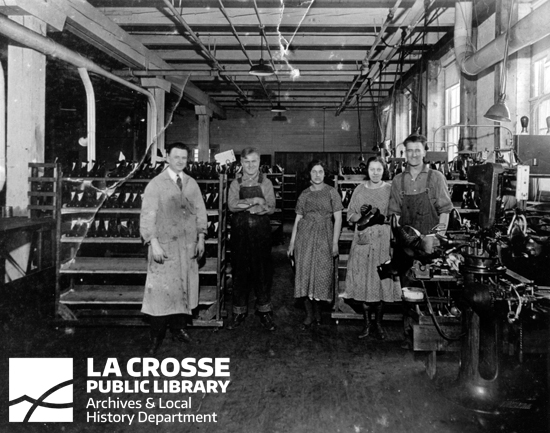
In 1986, the company changed its name to La Crosse Footwear, Inc. In 2001, the factory closed its doors and the company headquarters moved to Portland, Oregon. The company is still called LaCrosse Footwear and still produces premium rubber boots sporting innovative patents of materials and designs that were originally born right here in La Crosse.

